Crystal Structure and Biochemical Analysis of a Cytochrome P450 Steroid Hydroxylase ( Ba CYP106A6) from Bacillus Species.
Kim, K.H., Do, H., Lee, C.W., Subedi, P., Choi, M., Nam, Y., Lee, J.H., Oh, T.J.(2023) J Microbiol Biotechnol 33: 387-397
- PubMed: 36655276
- DOI: https://doi.org/10.4014/jmb.2211.11031
- Primary Citation of Related Structures:
8HG9 - PubMed Abstract:
Cytochrome P450 (CYP) is a heme-containing enzyme that catalyzes hydroxylation reactions with various substrate molecules. Steroid hydroxylases are particularly useful for effectively introducing hydroxyl groups into a wide range of steroids in the pharmaceutical industry. This study reports a newly identified CYP steroid hydroxylase ( Ba CYP106A6) from the bacterium Bacillus sp. and characterizes it using an in vitro enzyme assay and structural investigation. Bioconversion assays indicated that Ba CYP106A1 catalyzes the hydroxylation of progesterone and androstenedione, whereas no or low conversion was observed with 11β-hydroxysteroids such as cortisol, corticosterone, dexamethasone, and prednisolone. In addition, the crystal structure of Ba CYP106A6 was determined at a resolution of 2.8 Å to investigate the configuration of the substrate-binding site and understand substrate preference. This structural characterization and comparison with other bacterial steroid hydroxylase CYPs allowed us to identify a unique Arg295 residue that may serve as the key residue for substrate specificity and regioselectivity in Ba CYP106A6. This observation provides valuable background for further protein engineering to design commercially useful CYP steroid hydroxylases with different substrate specificities.
Organizational Affiliation:
Department of Life Science and Biochemical Engineering, Sunmoon University, Asan 31460, Republic of Korea.















